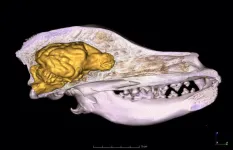(Press-News.org) It may now be time to ban artificial stone—a firm favourite for kitchen worktops in the UK— to ward off the incurable lung disease caused by its manufacturing and fitting, say a team of doctors in the journal Thorax after treating the first 8 cases of artificial stone silicosis reported in the UK.
Silicosis is caused by breathing in crystalline silica dust, and millions of people around the world are at risk of developing it as a result of their jobs in mining, quarrying, stone-cutting and construction, they note.
Made from crushed rocks bound together with resins and pigments, artificial stone, also known as engineered or reconstituted stone, or ‘quartz’, has surged in popularity over the past 20 years, particularly for use in kitchen worktops, they explain.
It has aesthetic appeal. It’s easier to work with due to the absence of natural imperfections, and it’s more resistant to damage than natural stone, they add.
But its increasing popularity has been accompanied by the emergence of a severe and rapidly progressive form of silicosis (artificial stone silicosis), largely driven by its high (more than 90%) silica content compared with marble (3%) and granite (30%), and the fine dust it generates when cut.
When worktops are prepared for installation, they are also often ‘dry’ cut and polished with an angle grinder or other hand tools without the use of water to suppress dust generation, further boosting the volume of fine dust, explain the authors.
Cases of artificial stone silicosis have been reported from Israel, Spain, Italy, the USA, China, Australia and Belgium since 2010. But while artificial stone has been used in the UK for a similar period, no cases had been reported until mid-2023, when 8 men were referred to a specialist occupational lung disease clinic.
Their average age was 34, but ranged from 27 to 56 at the time of diagnosis. Six were born outside the UK and seven smoked or used to smoke.
Their average cumulative exposure to stone dust was 12.5 years, but ranged from 4–40 years. Four of them had been exposed to stone dust for between 4 and 8 years and estimated that 50%–100% of the materials they had used were artificial stone with, in some, additional granite, marble, and other ‘natural’ stones.
Two were assessed for lung transplant; 3 were assessed for autoimmune disease. Two were treated for opportunistic lung infection caused by non-tuberculous mycobacteria.
All the men worked for small companies with fewer than 10 employees. Although none worked in worktop manufacture or installation they all carried out the ‘finishing’ process, specifically cutting and polishing the worktops before installation.
They all reported that this was done without consistent water suppression, and without what they felt was appropriate respiratory protection. And even where workshop ventilation was present, the men stated that the system had not been serviced or cleaned regularly. None of them was aware of active airborne dust monitoring in the workplace.
Against medical advice, three continue to work with artificial stone, and have subsequently reported reduced exposure to visible dust after the introduction of powered respirators and water suppression. Two are no longer working; one has continued to work, but is no longer exposed to the dust; one has died; and one has been lost to further check-ups.
“Onset of disease is likely to relate to exposure levels, suggesting levels, at least for some of the UK cases…were extremely high and implying that employers failed to control dust exposure and to adhere to health and safety regulations,” point out the authors.
“The [artificial stone] market is dominated by small companies in which regulation has been shown to be challenging to implement. Furthermore, at least some worktop manufacturers may fail to provide adequate technical information relating to potential risks,” they add.
“Even with cessation of exposure, disease progression has been noted in over 50% of cases over [an average] of 4 years. Prevention of disease is therefore critical,” they emphasise.
While the number of workers exposed to silica dust isn’t known, global experience indicates that cases are likely to increase significantly in the coming years, they point out.
Current UK guidance recommends monitoring workers in the industry after 15 years, but that is very likely to miss cases and fails to account for intensity, not just length, of exposure, they suggest.
“A concerted effort is required in the UK to prevent the epidemic seen in other countries. The cases we present illustrate the failure of the employer to take responsibility for exposure control in their workplaces. National guidelines are urgently needed, as well as work to enumerate the at-risk population and identify cases early,” they insist.
“The introduction of a legal requirement to report cases of [artificial stone] silicosis, implementation of health and safety regulation with a focus on small companies, and a UK ban on artificial stone (as introduced in Australia in 2024) must be considered,” they urge.
In a linked editorial, Dr Christopher Barber, of Sheffield Teaching Hospitals says that history is instructive, citing the observations of Dr Calvert Holland in 1843 on the health of Sheffield cutlery workers.
These workers shaped metal forks using a rotating grindstone and developed incurable ‘grinders asthma’ as a result of the very high levels of dust generated by ‘dry grinding’ forks (without water).
Barber comments: “By design, [artificial stone] worktops (like grindstones) have a very high silica content to make them more hard wearing and durable. Dry processing of [it] with powered tools without the use of water suppression, local exhaust ventilation, and respiratory protective equipment exposes workers to very high levels of airborne silica dust, in many cases two orders of magnitude greater than legal exposure limits.”
Holland noted the vulnerability of the cutlery workers, and Barber draws parallels with those working with artificial stone.
“Many of those at risk of [artificial stone] silicosis in the UK, Australia, and USA are migrant workers whose first language is not English, who may have poor understanding of health risks, and limited access to healthcare,” he writes.
And they are more likely to have limited financial options, forcing some to continue harmful exposures against medical advice, he adds.
“Considering the availability of [artificial stone] kitchen worktops, the arrival of [artificial stone] silicosis in the UK is one which has been feared by clinicians for some time,” he says.
But UK doctors may struggle to differentiate the signs and symptoms from sarcoidosis, a condition that is unrelated to silica inhalation, but which has similar clinical features, he suggests.
“Greater awareness of [artificial stone] silicosis is also required among a wider range of healthcare professionals due to the increased risk of mycobacterial, renal, and autoimmune connective [tissue] disease,” he says.
The UK is currently reviewing exposure limits for crystalline silica dust amid mounting international concerns about its health impacts.
To inform the current debate about permissible levels of exposure, researchers in a separate study reviewed for the first time the available evidence published up to the end of February 2023 to establish cumulative risk and identify the exposure level at which that risk would be reduced.
They searched for studies drawing on x-rays, post mortem examination results, and death certificates for silicosis, spanning an average period of more than 20 years since participants’ first employment in the stone cutting industry.
Eight studies out of an initial haul of 52 met the eligibility criteria, involving 8792 cases of silicosis among 65,977 participants. Six of the studies involved miners.
The cumulative risk estimates varied substantially, depending on which methodological approach had been used, so the researchers pooled the raw data to recalculate the lifetime cumulative risk and the level at which the absolute risk of developing the disease would be reduced.
The results showed that among miners halving cumulative exposure from 4 mg/m³ (equivalent to 40 years of work at 0.1 mg/m³ or 420 cases/1000 workers) to 2 mg/m³ (equivalent to 40 years of work at 0.05 mg/m³ intensity) of breathable silica dust corresponded to a substantial reduction in risk of 77%, resulting in 323 fewer cases/1000 workers.
The equivalent figures for those working in other industries were a reduction in risk of 45% and 23 fewer cases per 1000 workers down from 51. But, importantly, these figures are based on only 2 studies, highlight the researchers.
“There is current debate regarding respirable crystalline silica exposure limits in the UK and recent debate among miners in the USA. This research supports the reduction of permissible exposure limits from 0.1 mg/m³ to 0.05 mg/m³" over an 8-hour working shift, conclude the researchers.
END
Think about banning kitchen worktop favourite to ward off incurable lung disease, urge doctors
Call prompted by treating first 8 cases of artificial stone silicosis reported in UK
2024-08-07
ELSE PRESS RELEASES FROM THIS DATE:
Follow Australia’s lead and ban artificial stone, researchers urge European governments
2024-08-07
The UK and the European Union should follow Australia’s lead and ban the kitchen worktop favourite and cause of irreversible and rapidly progressive lung disease—artificial stone siliicosis—urge researchers in an editorial, published online in Occupational & Environmental Medicine.
And until a ban comes into force, all possible control measures should be legally enforced to minimise workers’ exposure to the harmful crystalline silica dust generated during its manufacture and fitting, insist the authors.
Artificial stone (also known as engineered stone) is widely used for surfaces ...
Reducing child poverty in England would significantly boost child health and narrow health inequalities
2024-08-07
Renewed efforts to reduce child poverty in England between now and 2033, such as removing the 2-child limit on child benefit, would significantly boost several aspects of child health and narrow health inequalities across the country, finds research published online in the Journal of Epidemiology & Community Health.
Tackling it would substantially cut the number of infant deaths and children in care, as well as rates of childhood nutritional anaemia and emergency admissions, with the most deprived regions, especially ...
Cut ties with Coca Cola in interests of athletes, spectators, and the planet, IOC urged
2024-08-07
The International Olympic Committee (IOC) should cut its ties with Coca Cola in the best interests of athletes, spectators, and the planet, urge Trish Cotter and Sandra Mullin of the international public health organisation, Vital Strategies, in an editorial to be published shortly in the open access journal BMJ Global Health.*
The company’s sponsorship forces athletes to implicitly endorse unhealthy sugary drinks and provides Coca Cola with elite access to political and corporate leaders to exert its influence, insist the authors.
Coca Cola has sponsored the Olympic Games for almost 100 years, they note. And there’s ...
Bloomberg Philanthropies makes founding gift to Xavier Ochsner College of Medicine
2024-08-07
Today, Bloomberg Philanthropies announced a gift of $5 million in seed funding to support the creation of the Xavier Ochsner College of Medicine (XOCOM), a newly established medical school in New Orleans founded by Xavier University of Louisiana and Ochsner Health.
Earlier this year, Xavier University of Louisiana, a historically Black college and university (HBCU) with a strong track record of sending graduates into the medical field, and Ochsner Health, the Gulf South’s leading not-for-profit health system with a long academic ...
Domestication causes smaller brian size in dogs than in the wolf, but such an evolutionary change is not unusual in wild animals
2024-08-07
A recent study by László Zsolt Garamszegi from the Institute of Ecology and Botany, Centre for Ecological Research, Hungary, and Niclas Kolm from the Department of Zoology, Stockholm University, Sweden, challenges the long-held notion that domestication is the primary driver of reduced brain size in domesticated animals, specifically dogs. The study employs a phylogenetic comparative method to analyze whether the domesticated dog (Canis familiaris) exhibits a uniquely small brain relative to its body size compared to other canid species.
The prevailing belief has been that domestication leads to a significant ...
Gestational diabetes does not increase risk of breast cancer, large Danish study finds
2024-08-07
*Note this is an early release from the Annual Meeting of the European Association of the Study of Diabetes (EASD 2024, Madrid, 9-13 September). Please credit the meeting if using this material*
Women who develop gestational diabetes are not more likely to go on to be diagnosed with breast cancer, according to a study of almost three-quarters of a million mothers to be presented at this year’s Annual Meeting of the European Association for the Study of Diabetes (EASD) (Madrid, 9-13 September).
Gestational diabetes, a type of diabetes that can develop during ...
Chemical and nutritional profile of fruit, vegetables and co-products to improve human health
2024-08-06
New studies emphasize the vital role of fruits, vegetables, and their co-products in boosting human health and life expectancy. Packed with minerals, vitamins, and dietary fiber, these foods help prevent chronic diseases. Antioxidants in fruits and vegetables, such as vitamins and carotenoids, combat harmful free radicals.
To get more information and to contribute to the research, visit: bit.ly/46zTKFX
Combining various fruits like oranges, apples, grapes, and blueberries enhances antioxidant effects. Diets ...
Attitudes such as distrust of government can cause swine farmers to resist animal biosecurity: UVM study finds
2024-08-06
A new University of Vermont study published today in Nature: Scientific Reports examines the social and psychological aspects of farmers’ decisions about whether or not to implement biosecurity measures on pig farms. This is the first study to look at human behavior in biosecurity adoption among swine producers.
Through survey data and simulations, the scientists found that it is largely farmers’ attitudes, which have the biggest impact on farmers’ decision-making strategies regarding implementing farm biosecurity. Farmer’s attitudes ...
Scientists reach consensus for fasting terminology
2024-08-06
Dr. Eric Ravussin of Pennington Biomedical Research Center in Baton Rouge was one of 38 scientists from five continents to present the first international consensus on fasting terminology and key definitions. Published in Cell Metabolism, the recent study reflects the increasing popularity of diets tied to fasting and a significant increase in scientific studies of fasting. While the application of fasting is rapidly growing, there was previously no globally established terminology.
The panel was the first to bring ...
C-Path welcomes new advisory members to Alpha-1 Antitrypsin Deficiency consortium
2024-08-06
TUCSON, Ariz., August 6, 2024 — Critical Path Institute’s (C-Path) Critical Path for Alpha-1 Antitrypsin Deficiency (CPA-1) consortium today announced the addition of several key advisory members. The new members, recognized experts in their respective fields and patient advocacy organizations, will contribute their significant expertise to the consortium’s mission to accelerate drug development for Alpha-1 Antitrypsin Deficiency (AATD), a rare genetic disorder.
Joining the consortium are:
Alpha-1 Foundation
COPD Foundation
Global ...
LAST 30 PRESS RELEASES:
Trauma or toxic? A deep dive into the impact of stress on kids' health
Turning industrial exhaust into useful materials with a new electrode
ORNL to partner with Type One Energy, UT on world-class facility to validate next-gen fusion
New journal section tackles AI, ethics, and digital health communication
Jeonbuk National University researchers develop novel dual-chemical looping method for efficient ammonia synthesis
New study sheds light on stroke recovery via exercise-induced migration of mitochondria
SEOULTECH researchers develop sodium-based next-generation smart electrochromic windows
Data-driven analysis reveals three archetypes of armed conflicts
Heart disease, stroke deaths down, yet still kill more in US than any other cause
Light switches made of ultra-thin semiconductor layers
Creative talent: has AI knocked humans out?
Sculpting complex, 3D nanostructures with a focused ion beam
A year after undermining Bredt’s rule, UCLA scientists have made cage-shaped, double-bonded molecules that defy expectations
Human activities drive global dryland greening
PeroCycle announces new appointments as it builds a world-class board for meaningful climate impact
Magnetic avalanches power solar flares
LeapSpace goes live: the Research-Grade AI-Assisted Workspace built on trusted science
DNA tests reveal mysterious beluga family trees
Strategic sex: Alaska’s beluga whales swap mates for long-term survival
How early cell membranes may have shaped the origins of life
Cannabis legalization is driving increases in marijuana use among U.S. adults with historically lower consumption rates
Multifunctional dipoles enabling enhanced ionic and electronic transport for high‑energy batteries
Triboelectric nanogenerators for future space missions
Advancing energy development with MBene: Chemical mechanism, AI, and applications in energy storage and harvesting
Heteroatom‑coordinated Fe–N4 catalysts for enhanced oxygen reduction in alkaline seawater zinc‑air batteries
Meta-device for precision lateral displacement sensing
Plasma-guided mitotane for the treatment of adrenocortical carcinoma: adjuvant care to advanced disease
Theoretical study of laser-enhanced nuclear fusion reactions
Social environment impacts sleep quality
Optimized kinetic pathways of active hydrogen generation at Cu2O/Cu heterojunction interfaces to enhance nitrate electroreduction to ammonia
[Press-News.org] Think about banning kitchen worktop favourite to ward off incurable lung disease, urge doctorsCall prompted by treating first 8 cases of artificial stone silicosis reported in UK



